Click image for BBB rating
See our Privacy Policy
cool="cool" width="784" height="9450" border="0" cellpadding="0" cellspacing="0" gridx="16" showgridx="showgridx" usegridx="usegridx" gridy="16" showgridy="showgridy" usegridy="usegridy" bgcolor="#99ccff">
|
|
|
 |
|
|
|
|
|
|
|
Welcome to Spaightwood Galleries, Inc.
120 Main Street, Upton MA 01568-6193
You can follow us on Facebook and Twitter!
We blog regularly on Facebook and announce special events and special sales on both sites.
Old Master Prints: Albrecht Durer (Nuremburg, 1471-1528), Saints, Martyrs, Heroes
|
|
|
|
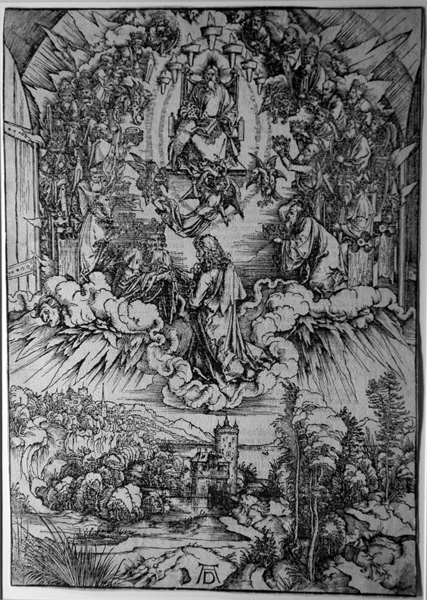 |
|
|
|
|
|
|
|
St .John before God and the Elders (Bartsch 63, Strauss 43, Meder 166). Original woodcut, c. 1496 for The Apocalypse. The work draws details from Revelations 4 to 5: 1-8. Ours is a good impression from the 1511 Latin text edition (which was better printed than the 1498 Latin or German editions) with the High Tower watermark (Briquet 15.863, c. 1475). Several expertly repaired tears visible only from the verso. Faint stains on the left door that has just swung open to reveal the Divine Presence. A good strong impression of this important early work. Strauss (Woodcuts, 153) notes that Durer's Apocalypse was the first book conceived, illustrated, and published by an artist. The two worlds of the woodcut—the earthly landscape and the heavenly scene revealed to the eyes of the Saint and the artist—exist on entirely different planes, and the heavenly one is by far the more striking. Perhaps the foundation for Durer's success in this series, as Strauss notes (p. 154), is that "he succeeded in a new and phenomenal way in creating a feeling of the Mysterium, an awe-filled awareness of the limitations of man's understanding." One of Durer's most desirable images. 392x277mm. Price: SOLD.
|
|
|
|
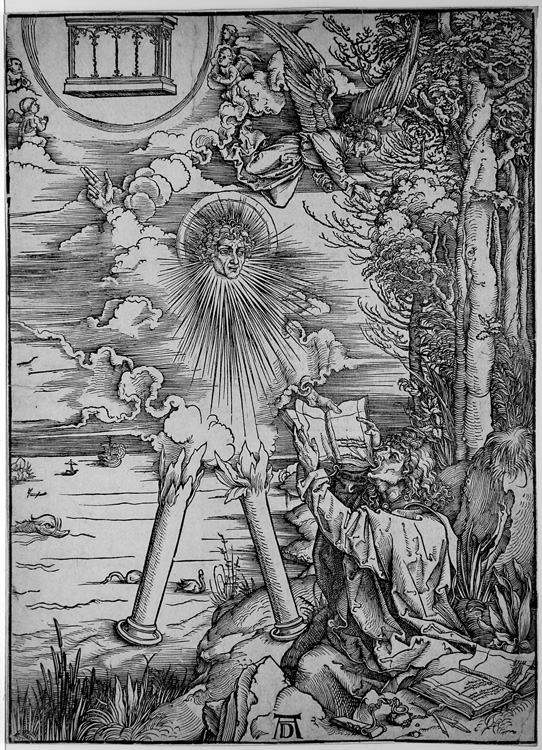 |
|
St John devouring the Book (Bartsch 70, Strauss 53, Meder 172). Original woodcut, c. 1497-98 for The Apocalypse. The work draws details from Revelations 10. Original woodcut from the 1498 German edition of The Apocalypse, which Meder describes (Strauss, p. 155) as "Carefully printed and very rare." He also calls it (Strauss, p. 196) "clear and bright; brilliant; rarely with full borders; frequently with three breaks in the right portion of the lower border; gaps in the left border below the small angel; also opposite on the right border." Our impression is before the breaks lower right and with only one small break in the left border below the small angel. We also have full borders top, bottom, and left; the right edge seems to have been slightly trimmed, but there is still some border visible. Repaired tear upper center to the right of the border, small restored upper and lower right corners. The German text verso exactly matches the reproduction illustrated in the 1964 facsimile of the 1498 German text of the Apocalypse (although our impression is better than the one illustrated in the work). Strauss comments, "If a mystery can be made plausible, then Durer has succeeded . . . in doing just that. He renders the incredible credible, retains the mysterious, and yet invites the viewers to interpret and understand what is happening. As a means to this end, he has invented a new graphic language" (p. 195). Image size: 390x280mm. Price: Please call or email for current pricing information.
|
|
|
|
|
|
|
Apocalypse 10: 1-10: "And I saw another mighty angel coming down from heaven, wrapped in a cloud, with a rainbow over his head; his face was like the sun, and his legs like pillars of fire. He held a little scroll open in his hand. Setting his right foot on the sea and his left foot on the land, he gave a great shout, like a lion roaring. And when he shouted, the seven thunders sounded. And when the seven thunders had sounded, I was about to write, but I heard a voice from heaven saying, “Seal up what the seven thunders have said, and do not write it down.” Then the angel whom I saw standing on the sea and the land raised his right hand to heaven and swore by him who lives forever and ever, who created heaven and what is in it, the earth and what is in it, and the sea and what is in it: “There will be no more delay, but in the days when the seventh angel is to blow his trumpet, the mystery of God will be fulfilled, as he announced to his servants, the prophets.” Then the voice that I had heard from heaven spoke to me again, saying, “Go, take the scroll that is open in the hand of the angel who is standing on the sea and on the land.” So I went to the angel and told him to give me the little scroll; and he said to me, “Take it, and eat; it will be bitter to your stomach, but sweet as honey in your mouth.” So I took the little scroll from the hand of the angel and ate it; it was sweet as honey in my mouth, but when I had eaten it, my stomach was made bitter." Durer omits the seven thunders, but uses most of the rest of the passage.
|
|
|
For additional woodcuts from Dürer's Apocalypse, click here.
|
|
|
|
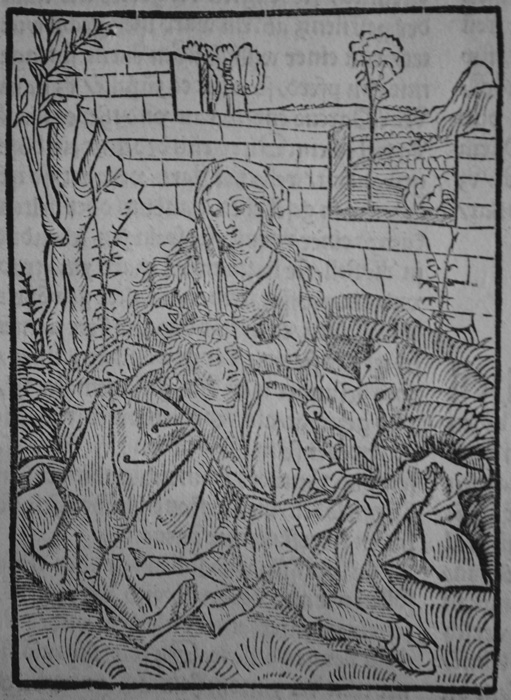 |
|
Samson and Delilah: Fools who tell secrets (chapter 51 of Das Narrenschiff). Woodcut after Durer, 1494. Ours is an impression on laid paper from the 1520 Strasbourg edition, the last printed from Durer's woodblocks. Image size: 113x81mm. Price: Please call or email for current pricing information.
"Fool he who tells his secret plan / To wife or any other man, / Thus mighty Samson, less than wise, / Lost strength and locks and both his eyes."
|
|
|
|
|
|
|
|
|
|
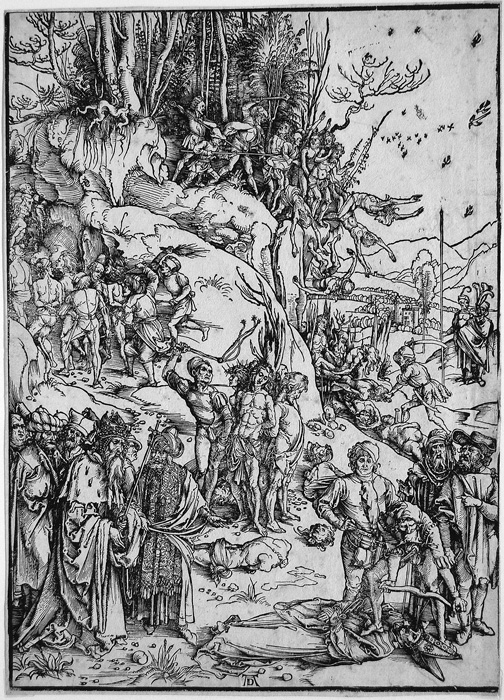 |
|
|
Martydom of the Ten Thousand (B. 117, S. 35, Meder 218a/b). Original woodcut, 1496. One of Dürer's earliest major prints, this is also one of his most crowded prints. A very good dark and well-inked Meder a/b impression on laid paper with no watermark. Meder dates our impression to c. 1504 and describes it as "strong, juicy."Although the crack in the top has not yet occurred, it has the gap in the contour of the mountain. A very good dark and well-inked impression with wide border lines on the top, bottom, and left sides. Repairs to the lower right border; small to thread margins. Image size: 388x285mm. Price: Please call or email for current pricing information.
|
|
|
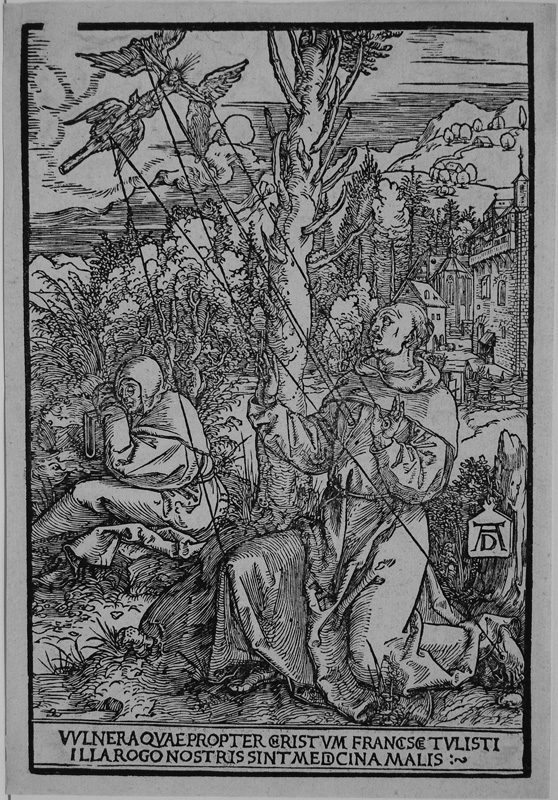 |
|
|
|
St. Francis receiving the Stigmata: Modest Woodcut 6 (B. 85, S. 85b, M. 224). Original woodcut, c. 1503-4. Strauss reminds us that this is the only one of the "Modest" Woodcuts that has a text ("The wounds which for Christ you bore, O Franciscus, I pray that they may be medicine for our ills.") Strauss suggests that this work may have been commissioned by the Prioress of the Franciscan convent in Nurembourg, Pirckheimer's sister Clara. He suggests that "The rendering is traditional and closely akin to the illustration for a postilla (Strauss no. 73). The images derives from a passage in the Legenda Aurea: "during a vision, 'a crucified seraph pressed his stigmata so deeply onto St. Francis that it seemed as if he himself had been crucified.' " Meder calls this woodcut "rare." Image size: 218x147mm. Price: Please call or email for current pricing information.
|
|
|
|
|
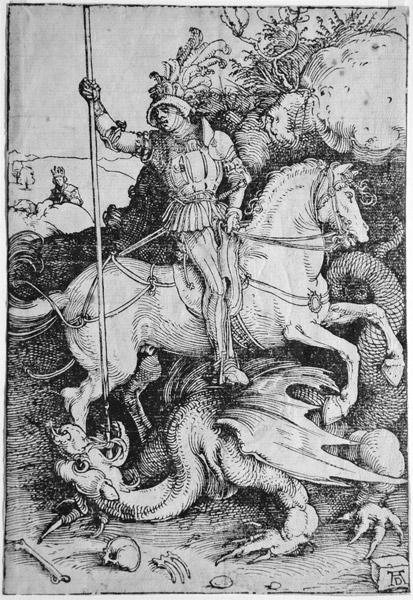 |
|
St. George on horseback (B. 111, S. 90, M. 225 d). Original woodcut, c. 1504-5. A good 16th century impression with margins trimmed to the block line. Reinforced crease on verso. One of Durer's early masterpieces. Ex-collections Kupferstichkabinett der Staatlichen Museum (Lugt 1606 & 2398) and K.F.F. von Nagler (L. 2529). Strauss observes that Durer's "drastic use of alternating black and white areas and the relief effect set it apart from most other works in this medium. The horse suggests that Durer had seen a drawing of Leonardo's; Durer's work in turn serves as a model for Lucas Cranach the Elder's "Chiaroscuro" woodcut on the same subject (B. 65) executed in 1507. Image size: 211x143mm. Price: SOLD.
|
|
|
|
|
|
|
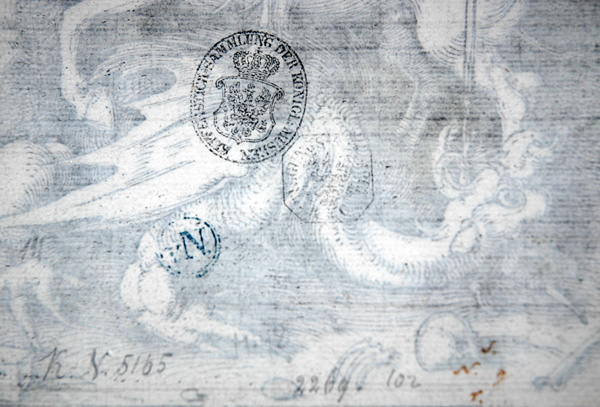 |
|
|
Verso, St. George on horseback (B. 111, S. 90, M. 225 d). Original woodcut, c. 1504-5. A good 16th century impression with margins trimmed to the block line. One of Durer's early masterpieces. Ex-collections Kupferstichkabinett der Staatlichen Museum (Lugt 1606 & 2398) and K. F. F. von Nagler (L. 2529).
|
|
|
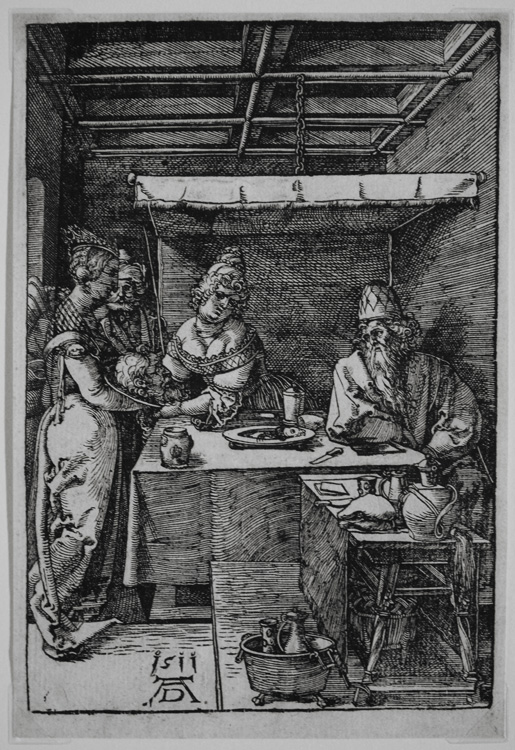 |
|
Salome presenting the head of John the Baptist to Herodias (Bartsch 126, Strauss 154, Meder 232). Original woodcut, signed in the block and dated 1511. The scene is described in Matthew 14: 3-11: "For Herod had arrested John, bound him, and put him in prison on account of Herodias, his brother Philip’s wife, because John had been telling him, “It is not lawful for you to have her.” Though Herod wanted to put him to death, he feared the crowd, because they regarded him as a prophet. But when Herod’s birthday came, the daughter of Herodias danced before the company, and she pleased Herod so much that he promised on oath to grant her whatever she might ask. Prompted by her mother, she said, “Give me the head of John the Baptist here on a platter.” The king was grieved, yet out of regard for his oaths and for the guests, he commanded it to be given; he sent and had John beheaded in the prison. The head was brought on a platter and given to the girl, who brought it to her mother." 1511 was a very prodcutive year for Durer the printmaker: he published the Small Woodcut Passion with Latin text verso as well as editions with Latin text of the Large Passion, The Apocalypse, and The Life of the Virgin. Ours is a very good, dark, and well-inked impression with strong contrasts. Small gap in the lower left corner. Ex-collection Hans von Aufsess (Lugt 2749, verso). Image size: 195x131mm. Price: Please call or email for current pricing information.
|
|
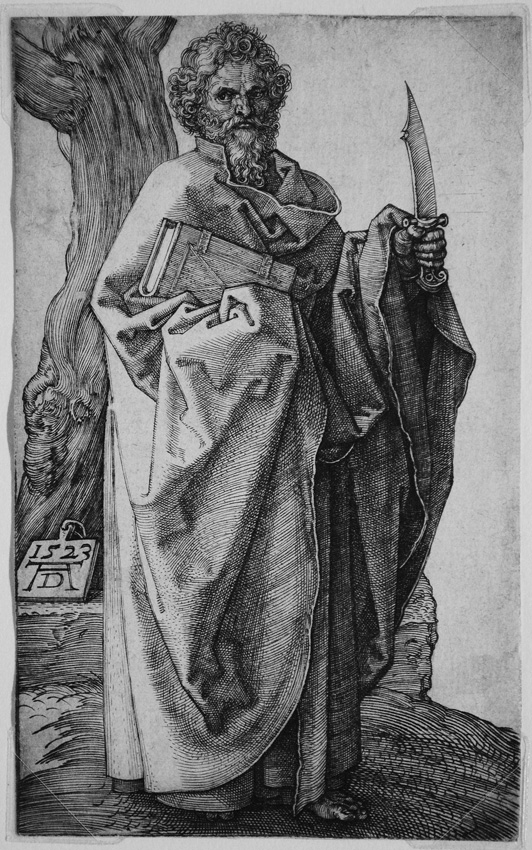 |
|
|
|
|
|
St. Bartholomew (Bartsch 47, Strauss 98b, Meder 45a). Original engraving, 1523. No watermark. A very good Meder a-b impression on laid paper with thread margins. Meder describes the "a" state as "strong and full of contrast"; our mpression has the fine wiping scratches visible in the right background and is printed dark and evenly overall. some abrasion upper left in the empty space to the left of the tree and about the leverl of the very top of that St. Bartholomew is holding. Winkler notes that St. Bartholomew's head grows out of the magnificent vestment, its symetry emphasized by the three peaks of hair and underlining his seriousness. A very strong impression of one of Dürer's most important engravings. Image size: 123x77mm. Price: Please call or email for current pricing information.
|
|
|
|
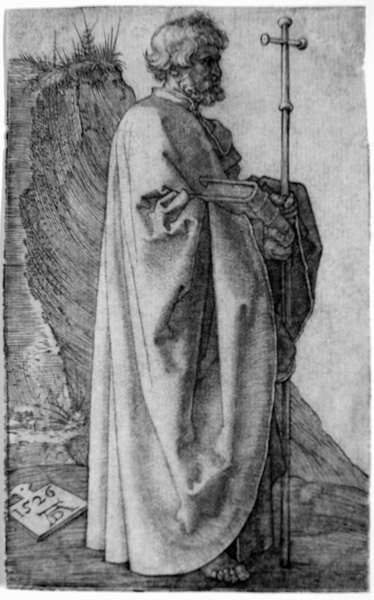 |
|
St. Philip (Bartsch 46, Meder 48 a/b, Strauss 103). Original engraving, 1526. A very good, evenly-printed and dark Meder a-b impression on laid paper. Trimmed on or just inside the platemark; 3 corners expertly repaired. Wolfflin comments, "The magnificently serene 'St. Philip' dispels all doubt of the character and spirit of Durer's last period." Winkler calls it "the most satisfying an noble representation of the Apostles." Image size: 120x76mm. Price: Please call or email for current pricing information.
|
|
|
|
|
|
|
|
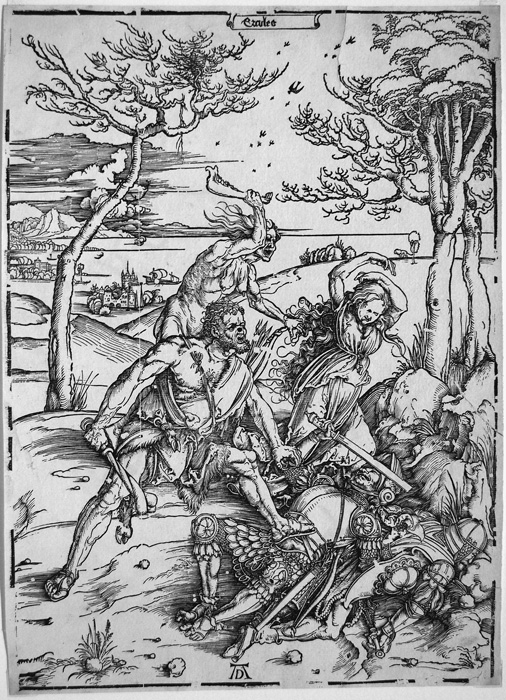 |
|
|
Hercules conquering the Molionide Twins (B. 127, S. 32, M. 238b). Original woodcut, c. 1496. Ouor impreession dates from c. 1580. It shows considerable wear, but is well printed on laid paper and still quite quite powerful. One of Dürer's earliest major prints and his only woodcut with a mythological theme. According to Strauss, the twin sons of Molione, Eurytsu and Kteatus, "were joined and their combined bodily strength exceeded that of any human." The twins (sons of Acter & Molione) were joined at the hip. Strauss adds that "Hercules is wearing a boar's skin because this event took place before the slaying of the Nemean lion (who can be seen in the background crossing the hill towards the left next to the little tree). This is one of Dürer's most dramatic prints. A later 16th- century impression on white laid paper. Repairedd tears in the ssky top center-right and in the loweer right corner. There are many breaks in the border lines; Hercules's nose is broken, but the work is still quite powerful. The original woodblock is in the British Mseum. Image size: 393x282mm. Price: Please call or email for current pricing information.
|
|
|
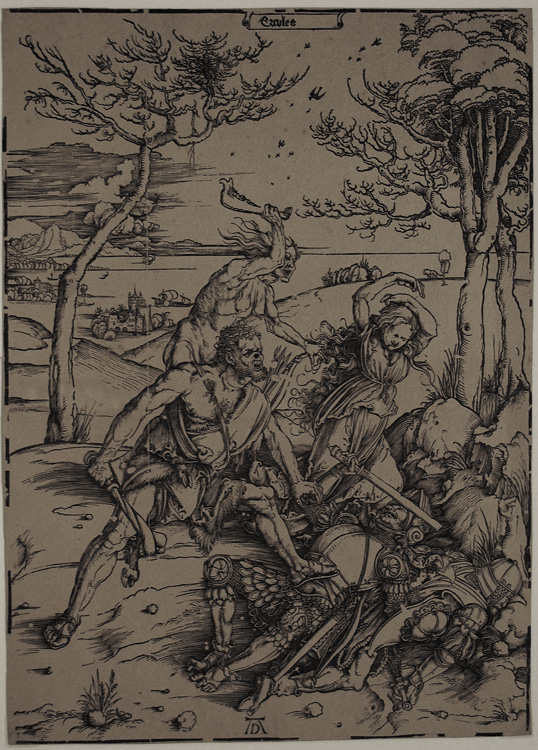 |
|
|
Hercules conquering the Molionide Twins (B. 127, S. 32, M. 238c). Original woodcut, c. 1496. One of Dürer's earliest major prints and his only woodcut with a mythological theme. According to Strauss, the twin sons of Molione, Eurytsu and Kteatus, "were joined and their combined bodily strength exceeded that of any human." The twins (sons of Acter & Molione) were joined at the hip. Strauss adds that "Hercules is wearing a boar's skin because this event took place before the slaying of the Nemean lion (who can be seen in the background crossing the hilltowards the left right next to the little tree. This is one of Dürer's most dramatic prints. A 17th- century impression showing considerable wear, but the impression is well printed on dark laid paper and still quite powerful. Image size: 393x282mm. Price: Please call or email for current pricing information.
|
|
|
Spaightwood Galleries, Inc.
To purchase, call us at 1-800-809-3343 (1-508-529-2511 in Upton MA & vicinity) or send an email to spaightwood@gmail.com
We accept AmericanExpress, DiscoverCard, MasterCard, and Visa.
We also accept wire transfers and paypal.
For directions and visiting information, please call. We are, of course, always available over the web and by telephone (see above for contact information). Click the following for links to past shows and artists. For a visual tour of the gallery, please click here. For information about Andy Weiner and Sonja Hansard-Weiner, please click here. For a list of special offers currently available, see Specials.
All works are sold with an unconditional guarantee of authenticity (as described in our website listing).
Copyright 2004-2017, Spaightwood Galleries, Inc.
Go back to the top of this page.
Visiting hours: Saturday 10:00 am to 5:00 pm and Sunday noon to 6:00 pm and other times by arrangement.
Please call to confirm your visit. Browsers and guests are welcome.
|
|
|
|
|
|
|
|
|
|
|
|
|
|
|
|
|
|
|
|
|
|
|
|
|
|
|
|
|
|
|
|
|
|
|
|
|
|
|
|
|
|
|
|
|
|
|











